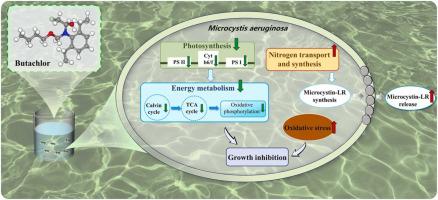Journal of Hazardous Materials ( IF 12.2 ) Pub Date : 2023-02-18 , DOI: 10.1016/j.jhazmat.2023.131042 Jing Yu 1 , Hui Zhu 2 , Heli Wang 3 , Brian Shutes 4 , Tingting Niu 5

|
The rapid development of agriculture increases the release of butachlor into aquatic environments. As a dominant species causing cyanobacterial blooms, Microcystis aeruginosa (M. aeruginosa) can produce microcystin and poses threats to aquatic ecosystems and human health. However, the impact of butachlor on M. aeruginosa remains unclarified. Therefore, the physiochemical responses of M. aeruginosa to butachlor were investigated, and the relevant underlying molecular mechanism was highlighted. There were no significant changes (P > 0.05) in the growth and physiology of M. aeruginosa at the low concentrations of butachlor (0–0.1 mg/L), which evidenced a high level of butachlor tolerance in Microcystis aeruginosa. For the high concentrations of butachlor (4–30 mg/L), the inhibition of photosynthetic activity, disruption of cell ultrastructure, and oxidative stress were dominant toxic effects on M. aeruginosa. Additionally, the impaired cellular integrity and lipid peroxidation may be attributed to the substantial elevations of extracellular microcystin-LR concentration. Downregulation of genes associated with photosynthesis, energy metabolism, and oxidative stress was inferred to be responsible for the growth suppression of M. aeruginosa in 30 mg/L butachlor treatment. The upregulation of gene sets involved in nitrogen metabolism may illustrate the specific effort to sustain the steady concentration of intracellular microcystin-LR. These findings dissect the response mechanism of M. aeruginosa to butachlor toxicity and provide valuable reference for the evaluation of potential risk caused by butachlor in aquatic environments.
中文翻译:

丁草胺对铜绿微囊藻的影响:毒性的细胞和分子机制
农业的快速发展增加了丁草胺向水生环境的排放。铜绿微囊藻(M. aeruginosa)作为蓝藻水华的优势种,可产生微囊藻毒素,对水生生态系统和人类健康构成威胁。然而,丁草胺对铜绿假单胞菌的影响仍不清楚。因此,研究了铜绿分枝杆菌对丁草胺的生理化学反应,并突出了相关的潜在分子机制。低浓度丁草胺(0-0.1 mg/L),证明铜绿微囊藻对丁草胺具有高水平的耐受性。对于高浓度的丁草胺 (4–30 mg/L),光合作用活性的抑制、细胞超微结构的破坏和氧化应激是对铜绿假单胞菌的主要毒性作用。此外,细胞完整性受损和脂质过氧化可能是由于细胞外微囊藻毒素-LR 浓度显着升高所致。与光合作用、能量代谢和氧化应激相关的基因下调被推断是导致30 年铜绿分枝杆菌生长抑制的原因 mg/L 丁草胺处理。参与氮代谢的基因集的上调可能说明维持细胞内微囊藻毒素-LR 稳定浓度的具体努力。这些研究结果剖析了绿脓杆菌对丁草胺毒性的反应机制,为评估丁草胺在水生环境中的潜在风险提供了有价值的参考。






























 京公网安备 11010802027423号
京公网安备 11010802027423号